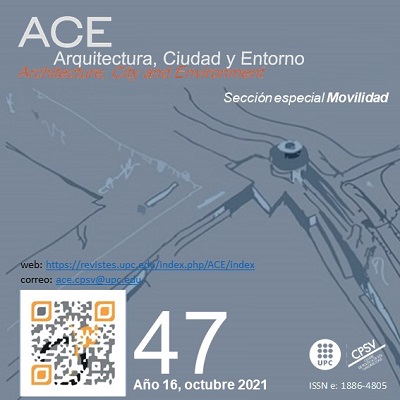Accesibilidad urbana y conectividad de los centros de empleo en Culiacán
DOI:
https://doi.org/10.5821/ace.16.47.9694Palabras clave:
Acceso, centralidad, red, ciudad monocéntricaResumen
El análisis del acceso a las oportunidades de la ciudad es el objetivo de la evolución del paradigma de movilidad a uno de accesibilidad urbana. En este artículo, dicho análisis está enmarcado por las teorías de la ciudad monocéntrica y la centralidad de la red, esta última como aproximación a la accesibilidad con base en la infraestructura vial que soporta los viajes. El presente estudio se enfoca en la concentración de las actividades laborales y la conectividad como cualidad de los vínculos relevantes entre el empleo y la población ocupada. Para el abordaje de la conectividad se utilizaron cuatro medidas diferentes de centralidad por medio de herramientas de procesamiento en SIG: por cercanía, grado de centralidad, por intermediación y “eigenvector”, procurando un análisis múltiple de la red. Con respecto a la concentración del trabajo en la ciudad, se aplicaron los métodos de identificación de subcentros urbanos: picos de densidad de empleo en zonas contiguas y umbrales de concentración. Para estos métodos se utilizó información del INEGI, disponible a nivel nacional en México. Los resultados revelan cuantitativamente los rasgos de conectividad de la red de la ciudad y la fuerza del centro urbano debido a la concentración de empleos y su conectividad. De igual forma para cada centro de empleo, según el número de puestos ocupados, población ocupada con accesibilidad potencial y la conectividad de su área de servicio, expresada por las diferentes formas de centralidad.
Publicado
Número
Sección
Licencia
COPYRIGHT
El contenido de los artículos y los comentarios en ellos expresados son responsabilidad exclusiva de sus autores, y no reflejan necesariamente la opinión del comité editor de la revista. Los trabajos publicados por ACE pueden reproducirse bajo la licencia CC-BY-NC-ND 3.0 ES más información http://creativecommons.org/licenses/by-nc-nd/3.0/es/
Lo que implica que las personas autoras sólo retienen y mantienen los derechos de Copyright dentro de las limitaciones incluidas en la licencia anterior.





































